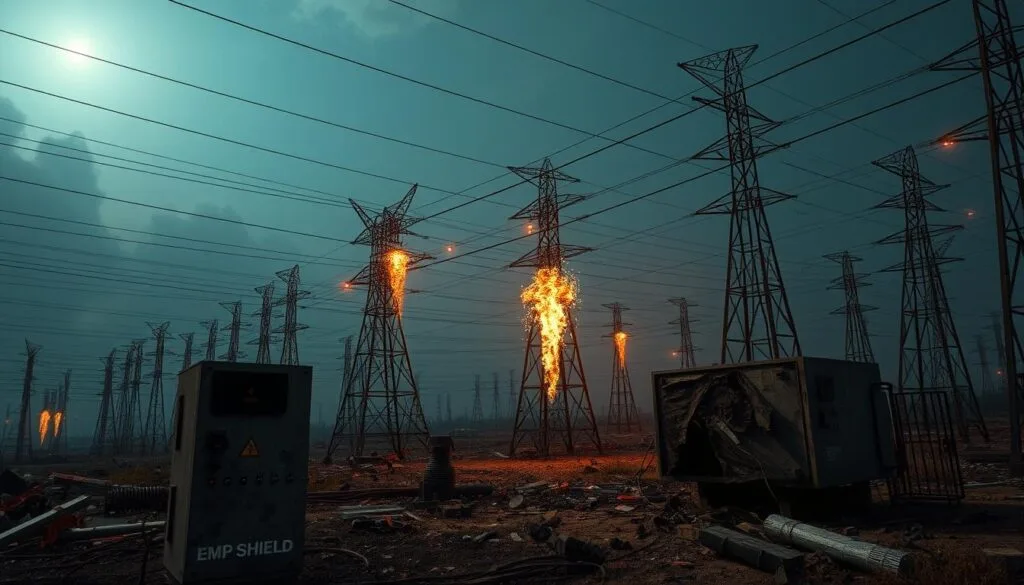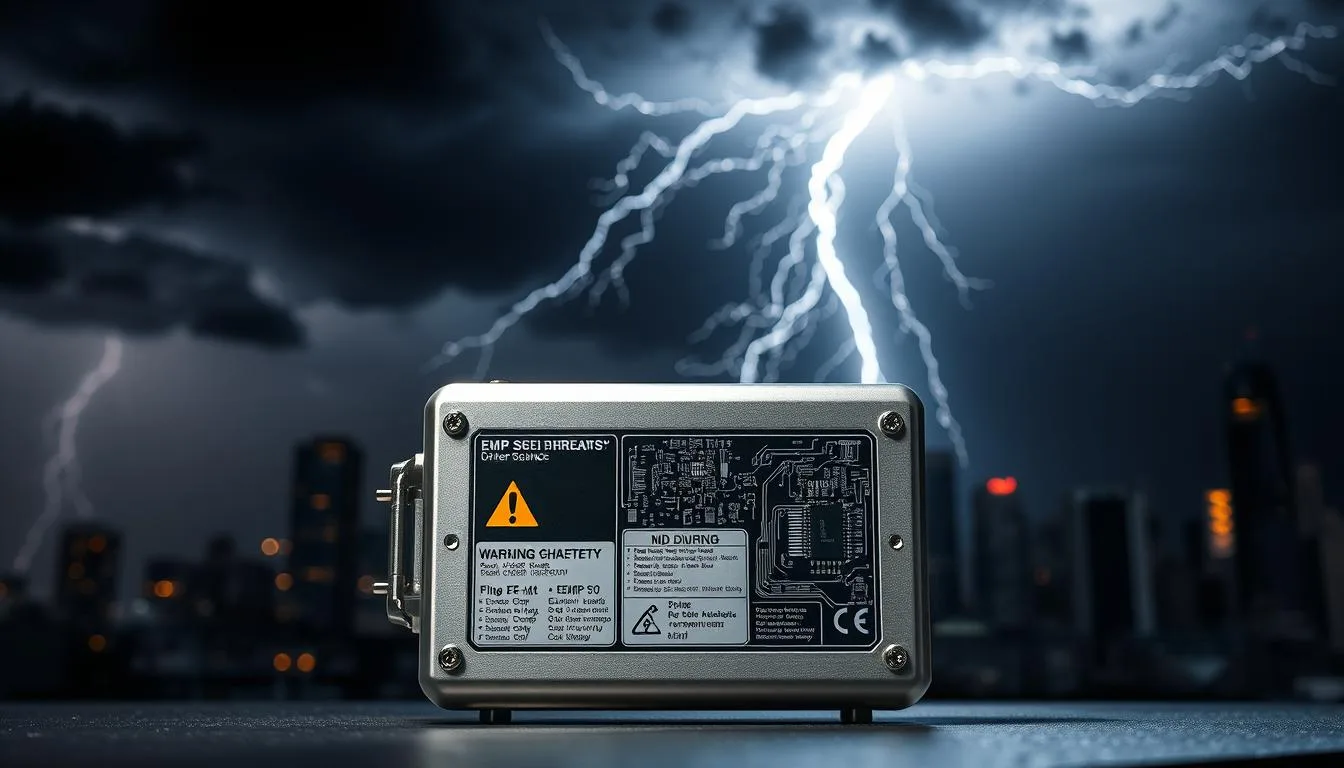What invisible force could silently cripple modern life in seconds? Imagine losing power, communication, and transportation overnight—not from hackers or bombs, but a burst of energy you can’t see. This isn’t science fiction. It’s the reality of electromagnetic pulses (EMPs), and their origins might surprise you.
An EMP is a sudden surge of electromagnetic energy that can fry electronics, overload circuits, and disrupt critical systems. While often linked to nuclear weapons (think Cold War-era fears), these pulses also occur naturally. Solar storms, like the 1859 Carrington Event, remind us that nature packs its own punch.
Today’s tech-dependent world faces dual risks. On one side, extreme space weather threatens power grids. On the other, human-made threats—like high-altitude detonations—could trigger cascading failures. The 2003 Northeast blackout, caused by a tree branch, shows how fragile our infrastructure really is.
Protecting devices isn’t optional anymore. Solutions like EMP Shield act as insurance against these silent threats. Want to safeguard your home? Explore EMP Shield here.
This article breaks down how pulses work, why energy types matter, and what makes radiation so destructive. Let’s decode the science—because preparedness starts with understanding.
Key Takeaways
- Electromagnetic pulses come from natural sources (solar storms) and human activity (nuclear tests).
- These energy bursts can disable electronics and power systems within moments.
- Historical events prove both nature and humans can create widespread disruptions.
- Modern infrastructure remains alarmingly vulnerable to pulse-related damage.
- Protective measures, like specialized shielding, help mitigate risks to critical devices.
Understanding EMPs: Natural Phenomena and Man-Made Events
Picture this: your phone dies mid-call, traffic lights go dark, and hospital monitors flatline—all at once. These scenarios could unfold during an electromagnetic pulse event, a split-second energy surge capable of disabling modern technology.
Defining Electromagnetic Pulses
An electromagnetic pulse (EMP) is a rapid burst of energy that interacts with conductive materials. Three main types exist:
| Type | Source | Impact |
|---|---|---|
| E1 | Nuclear detonations | Fries microchips instantly |
| E2 | Lightning strikes | Mimics natural electrical surges |
| E3 | Solar storms | Overloads power grids for hours |
| Solar EMP | Sun eruptions | Disables satellites globally |
Sources: From Solar Storms to Nuclear Detonations
Earth’s magnetic field constantly battles two energy sources. Solar flares—like the 1989 Quebec blackout culprit—release charged particles that induce currents in power lines. Human-made bursts, such as those from high-altitude nuclear tests, create overlapping waves that overwhelm circuits.
Modern electronics face unique risks. A smartphone contains 15 billion transistors vulnerable to E1 pulses. Power transformers can melt under sustained E3 currents. The United States government identifies these threats in national security reports, urging proactive EMP Shield solutions for critical infrastructure.
While lightning rods protect against localized strikes, widespread pulse events demand specialized shielding. Devices like EMP Shield redirect harmful energy away from sensitive components, acting as a first line of defense against both cosmic and human-caused surges.
EMPs natural vs man-made: A Detailed Comparison
Modern civilization balances on a knife’s edge between celestial fireworks and human ingenuity gone awry. Let’s examine two distinct sources of electromagnetic disturbances through real-world examples and expert analysis.
Root Causes and Real-World Consequences
Solar flares create continent-sized challenges. The 1989 Quebec blackout left six million Canadians without power for 12 hours after a solar storm overloaded transformers. Recovery took days – and that was just one province.
Human-caused incidents pack different punches. A 1962 high-altitude nuclear test disabled streetlights 900 miles away in Hawaii. “The right pulse in the wrong place could collapse national grids for months,” warns a Congressional EMP Commission report.
Probability vs. Potential Damage
Consider these contrasts:
| Factor | Solar Events | Human-Created |
|---|---|---|
| Frequency | Every 50-100 years | Rare but possible |
| Warning Time | Days | Minutes |
| Recovery | Weeks | Years |
Power grids face unique risks. The 2003 Northeast blackout proved how quickly cascading failures can spread. Critical systems like hospitals and water treatment plants remain particularly vulnerable to sustained outages.
Geographic reach varies dramatically. While solar storms affect entire hemispheres, targeted human-made pulses could disable specific regions. Response plans must account for these differences – urban centers face different challenges than rural areas.
“We’re more prepared for solar weather than deliberate attacks, but neither threat gets adequate attention.”
Understanding these distinctions helps prioritize protection efforts. While we can’t stop solar flares, we can harden essential infrastructure against both types of threats through smart shielding and system redundancies.
Impact on Critical Infrastructure and Electronics
Imagine entire cities going dark as power transformers explode like popcorn kernels. That’s not a movie plot—it’s what happens when high-energy pulses meet modern infrastructure. Critical systems we rely on daily face unprecedented risks from sudden electromagnetic disturbances.

Effects on the Electrical Grid and Communication Systems
Power grids act like giant antennas during pulse events. A 2013 Lloyds report estimates a severe solar storm could leave 40 million Americans without electricity for years. Transformers can’t handle sustained voltage spikes—once damaged, replacements take months to build.
Communication networks face similar threats. Cell towers and fiber optic hubs rely on delicate electronics. During the 2003 Northeast blackout, 50 million people lost phone service within minutes. Modern 5G systems use components even more sensitive to energy surges.
Vulnerabilities of Modern Electronic Equipment
Your car’s computer has over 100 microchips. Hospitals use 10,000 connected devices per facility. These all share a fatal flaw: they’re designed for efficiency, not resilience. Energy surges as low as 50 volts can fry circuit boards instantly.
Industrial equipment suffers worst. Water treatment plants use programmable logic controllers that fail under irregular currents. A 2020 DOE study found 90% of U.S. power plants lack adequate surge protection.
Long-Term Societal and Economic Implications
Six months without power isn’t just inconvenient—it’s catastrophic. Grocery stores can’t refrigerate food. Pharmacies can’t dispense life-saving drugs. The National Academy of Sciences calculates a nationwide blackout could cost $7 trillion in the first year.
“We’ve built a glass house in a hailstorm zone. Hardening critical systems isn’t optional—it’s survival.”
Solutions like EMP Shield redirect harmful energy away from vital equipment. Combined with grid redundancies and Faraday cages, these measures form a layered defense against electromagnetic chaos. The time to act? Before the lights go out.
Mitigation Strategies and Protection: EMP Shield and Best Practices
Your smartphone’s survival could determine how you weather the next major crisis. Modern safeguards blend cutting-edge technology with practical steps anyone can implement.

How EMP Shield Defends Your Devices
EMP Shield acts like a lightning rod for pulse threats. It diverts harmful energy through military-grade surge suppression, protecting connected equipment in under 1 nanosecond. Third-party testing confirms its effectiveness against high-altitude electromagnetic pulse scenarios up to 50,000 volts.
| Protection Method | Application | Effectiveness |
|---|---|---|
| Faraday Cages | Small electronics | Blocks 99% of energy |
| Surge Protectors | Home appliances | Filters minor spikes |
| EMP Shield | Entire electrical systems | Neutralizes E1-E3 pulses |
| Grid Redundancies | Power infrastructure | Prevents cascading failures |
Hardening Techniques and Emergency Preparedness
Start with critical systems: install EMP Shield on your home’s main electrical panel. Store backup communication devices in metal trash cans lined with cardboard—an improvised Faraday cage. The DHS best practices guide recommends layered protection for maximum resilience.
Organizations should prioritize:
- Shielding server rooms with copper mesh
- Stockpiling analog backup systems
- Conducting annual pulse response drills
| Strategy | Action | Benefit |
|---|---|---|
| Energy Management | Install whole-house surge protection | Prevents overloads |
| Response Planning | Create EMP-specific emergency kits | Ensures continuity |
| Equipment Hardening | Use EMP-resistant components | Reduces replacement costs |
“Shielding residential electrical systems provides the first line of defense against both natural and intentional pulse events.”
Don’t wait for warning signs. Start hardening critical systems today with proven solutions like EMP Shield—because when seconds count, preparation makes all the difference.
Scientific Insights into Electromagnetic Pulse Phenomena
Your morning coffee maker could become a paperweight in nanoseconds. Understanding pulse behavior helps engineers design defenses against these invisible threats. Let’s break down the physics behind the chaos.
Pulse Waveforms and Frequency Ranges
EMP events create distinct energy patterns. The double-exponential waveform spikes rapidly then decays slowly—like a camera flash hitting metal. Nuclear blasts produce this shape, overwhelming circuits in microseconds.
Natural events often use damped sine waves. These oscillating patterns, seen in solar storms, build voltage gradually. Fourier analysis shows how these frequencies interact with electronics:
- High-frequency E1 pulses (1 MHz–1 GHz) bypass surge protectors
- Mid-range E2 bursts mimic lightning (1 kHz–1 MHz)
- Low-frequency E3 waves (0.1–10 Hz) strain power grids
Electromagnetic Compatibility and Infrastructure Resilience
Modern shielding uses layered defense strategies. Hospitals now install frequency-selective filters that block harmful ranges while allowing normal operations. The Department of Homeland Security recommends these for critical facilities.
Lab tests reveal stark contrasts:
| Protection Type | Response Time | Voltage Threshold |
|---|---|---|
| Basic surge protector | 10 nanoseconds | 6,000 volts |
| EMP Shield | 0.5 nanoseconds | 50,000 volts |
Engineers design redundancy into power stations using Faraday principles. Transformers now include automatic disconnect systems that activate before damaging currents build. As one researcher notes: “It’s like teaching infrastructure to duck before the punch lands.”
Conclusion
How many backup plans does your home have if the lights never come back on? This article revealed how energy surges—whether from solar flares or nuclear detonations—can cripple essential systems in moments. Our power grids and communication networks remain alarmingly fragile, as historical events like the 1989 Quebec blackout demonstrated.
Scientific research shows pulses target modern tech’s weakest points. High-frequency waves bypass basic surge protectors, while sustained currents melt transformers. The solution? Layered protection combining instant-response shielding with infrastructure hardening.
Products like EMP protection devices offer critical defense, neutralizing harmful energy in nanoseconds. Pair these with Faraday cages for small electronics and emergency protocols for hospitals. Remember: recovery times stretch from weeks to years depending on the attack type.
Grid stability demands proactive measures now—not after a crisis. Regular system audits, spare parts stockpiles, and community drills build resilience. As threats evolve, so must our strategies. Start safeguarding your home today with trusted solutions. When seconds count, preparation makes all the difference.
FAQ
How does a high-altitude electromagnetic pulse (HEMP) differ from a solar storm?
A HEMP is caused by a nuclear explosion in the atmosphere, creating a fast, intense burst that fries electronics. Solar storms, like coronal mass ejections, release slower-moving energy that can overload power grids. Both disrupt technology but differ in speed and origin.
Can everyday devices like cell phones survive an EMP event?
Unprotected devices are highly vulnerable. EMP Shield and Faraday cages block damaging surges. Cars with computerized systems might also fail unless hardened. Always keep backups for critical equipment.
Why is the electrical grid a major concern during an EMP attack?
Transformers and transmission lines are sensitive to voltage spikes. A widespread outage could take months to repair, crippling communication, healthcare, and supply chains. Grid resilience plans focus on shielding and redundancy.
What’s the likelihood of a man-made EMP event compared to natural ones?
Natural EMPs from solar activity occur regularly but vary in strength. Man-made threats, like nuclear detonations, are less likely but more destructive. Governments prioritize monitoring both through agencies like NOAA and DHS.
How do pulse waveforms impact infrastructure resilience?
Fast E1 pulses fry microchips, while slower E3 waves melt power lines. Modern infrastructure’s electromagnetic compatibility determines survival. Techniques like grounding and surge protection reduce risks.
Are there proven ways to protect homes from EMP damage?
Yes! EMP Shield products divert surges away from wiring. Combine this with Faraday bags for small electronics. For long-term safety, store solar generators and non-digital tools in shielded containers.
Could an EMP event cause permanent data loss in computers?
Absolutely. The burst can erase stored data and fry hard drives. Cloud backups on shielded servers or offline storage (like encrypted USBs in Faraday boxes) help mitigate this risk.
How do emergency response plans address EMP threats?
Agencies like FEMA recommend stockpiling essentials, analog tools, and radio backups. Communities are urged to test grid shutdown protocols and invest in hardened communication systems like HF radios.
